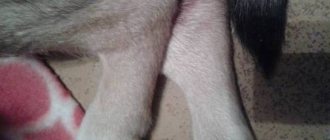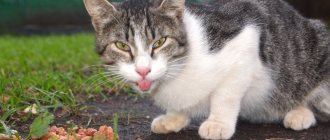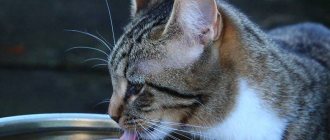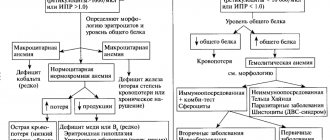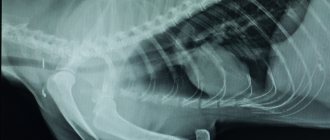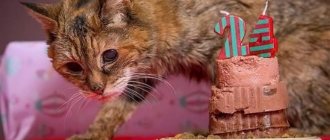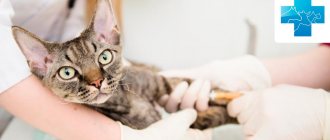Types of kidney failure
The disease is caused by dysfunction of the kidneys and urinary system, which leads to the inability to eliminate harmful toxins and other substances in the urine. The kidneys perform many useful functions in close interaction with other body systems, the main of which are:
- cleansing the blood of decay products (nitrogen compounds) and waste;
- retaining fluid and removing excess fluid;
- production of hormones vital for the body;
- regulation of blood pressure by controlling the flow of sodium into the blood.
If the kidneys malfunction, most functions cease to be performed, which entails severe toxicity (self-poisoning) of the body and can lead to the death of the animal within a few days.
The main causes of kidney dysfunction and failure:
- frequent or untreated inflammatory processes in the kidneys;
- mechanical or toxic damage to these organs;
- poisoning of various types;
- glomerulonephritis (impaired urine formation), including autoimmune;
- infectious and bacterial diseases (pyelonephritis);
- stones or tumors that interfere with excretory function;
- polycystic kidney disease (a genetic disease of some exotic cat breeds) - accompanied by the formation of cavities in the tissues that fill with fluid;
- congenital pathologies of the urinary organs;
- Unilateral hypoplasia, in which one of the kidneys lags behind the other in development, then in old age in cats the weak organ fails.
There are breeds that are genetically predisposed to this disease - Persian and Abyssinian.
To begin a course of treatment for renal failure in a cat, it is necessary to make an accurate diagnosis and establish the type of disease: acute (AKI) or chronic (CRF). Both varieties have similar symptoms, however, with chronic tissue, diseased organs degenerate, i.e. the process is irreversible, and there is no possibility of restoring their functions.
There is also another classification of this disease - based on the causes of occurrence:
- prerenal, when the pathology is caused by impaired blood supply to the kidneys due to severe dehydration or after the animal is under anesthesia;
- postrenal - develops against the background of improper outflow of urine due to urolithiasis and blockage of the canal;
- renal, which occurs when poisoned by toxins during chronic inflammation of the kidneys or other diseases.
Acute renal failure in cats
Golubeva Dina Viktorovna veterinary therapist
What is acute renal failure and why does it occur
Acute renal failure (ARF) is a severe pathological condition that involves impaired excretory function of the kidneys.
This process develops rapidly, is usually reversible, and is accompanied by sharp changes in the acid-base, water and electrolyte balance, a decrease in the excretion of various substances from the body by the kidneys and, as a result, their accumulation.
The causes of such changes are a sharp decrease in blood flow to the kidneys, damage to the kidney tissue and/or disturbances in the outflow of urine from the kidneys. In other words, acute renal failure occurs:
- Prerenal (“prerenal”) - develops with a sharp drop in blood pressure and disruption of intrarenal blood circulation, due to shock of various origins (bleeding, poisoning, infections, heat stroke), dehydration (for example, panleukopenia), heart failure.
- Renal (“renal”) – develops with bacterial infections of the kidneys (pyelonephritis), inflammatory kidney diseases (acute glomerulonephritis, interstitial nephritis) and systemic infectious diseases (viral immunodeficiency). The cause of the development of acute renal failure can be the effect on the tissue structures of the kidneys of various toxic substances (ethylene glycol, salts of heavy metals, aniline), drugs (aminoglycosides, chemotherapy drugs, radiocontrast agents, non-steroidal anti-inflammatory drugs and some other drugs), snake venom. Renal renal failure can be caused by blockage of the renal tubules with hemoglobin from destroyed red blood cells during their massive hemolysis, for example, with hemobartonellosis or as a result of diseases accompanied by the development of disseminated intravascular coagulation (poisoning with hemolytic poison, severe forms of sepsis).
- Postrenal (“postrenal”) – develops when the urinary tract (ureters, bladder or urethra) is blocked or compressed, for example by a tumor. The most common cause of acute renal failure in cats is urolithiasis.
In addition to the excretory function, the kidneys perform a number of other functions in the body - they regulate the composition of blood and other body fluids, participate in water-salt metabolism, the metabolism of proteins and carbohydrates, and synthesize biologically active substances that regulate blood pressure levels and the process of hematopoiesis. Therefore, renal failure (especially chronic) leads to additional disorders, such as a drop in hemoglobin levels, disorders of hormone-dependent functions and calcium metabolism.
Fluid and electrolyte imbalances, as well as the accumulation of metabolic products in the blood, give rise to complications in the cardiovascular and nervous systems, leading to gastrointestinal disorders and bleeding, as well as suppression of the immune system.
How does acute renal failure manifest?
Clinical signs of acute renal failure are nonspecific: general depression, changes in urine volume (decreased urine volume, up to complete cessation of urination), weakness, vomiting, diarrhea, decreased appetite or lack thereof, increased pulse rate, swelling, pallor or redness of the mucous membranes. The severity of clinical manifestations can vary from minor disorders, invisible to the owner, to the most severe disorders. If any such symptoms are detected, the animal should be taken to the clinic immediately.
Which patients most often have acute renal failure?
High-risk groups include patients suffering from kidney disease, severe trauma or systemic disease (pancreatitis, diabetes mellitus, cardiovascular disease, liver disease). Additional risk factors include dehydration, electrolyte imbalance, low or high blood pressure, fever, and sepsis.
How does a doctor diagnose acute renal failure?
The diagnosis of acute renal failure is made on the basis of information provided by the animal owner (history), examination, and most importantly, the results of laboratory tests. An important symptom is a decrease in the amount of urine excreted by the animal (oliguria) or its complete absence (anuria).
Upon examination, all or some of the following signs may be detected: the smell of urine in the exhaled air, pale mucous membranes, weakness, signs of dehydration, low temperature. The kidneys may be enlarged and painful.
According to laboratory tests, there is a rapid development of azotemia, that is, an increase in the content of urea and creatinine in the blood (they are the main indicators of kidney function). In addition, phosphorus levels and blood acidity usually increase.
A urine test reveals the presence of protein and glucose, as well as casts and renal epithelial cells in the sediment; the appearance of salt crystals and red blood cells is also possible. In addition, X-ray diagnostics are used, including with the introduction of special substances into the blood (for example, to exclude kidney stones, determine their size, the level of blood supply to the kidneys and other pathologies), ultrasound diagnostics and, in some cases, kidney biopsy.
Treatment
Treatment of patients with acute renal failure should be comprehensive and aimed at eliminating the cause, stimulating diuresis, correcting fluid and electrolyte imbalances, acid-base disorders, removing accumulated toxins from the body, and eliminating systemic complications. These patients require intensive therapy in an inpatient department of the clinic.
First of all, doctors try to eliminate the cause that caused the development of acute renal failure, which can naturally help restore diuresis.
If postrenal renal failure is established, it is necessary to ensure the free outflow of urine as soon as possible (insertion of a urinary catheter, pumping urine with a syringe through the abdominal wall, or through surgery).
In parallel, measures are being taken to restore the adequate process of formation and excretion of urine (drugs are prescribed that improve intrarenal blood flow, microcirculation in the kidney tissues, diuretics that are administered intravenously, strictly dosed using intravenous dispensers under the constant supervision of the attending physician).
To correct water-electrolyte balance and acid-base disorders, infusion therapy is necessary.
The choice of treatment tactics depends on the nature of the underlying and concomitant diseases, the degree of kidney damage and the general condition of the patient.
Infusion therapy is usually continued until the urea and creatinine levels reach normal levels, adequate diuresis is established, and the patient's general condition is stabilized.
During the treatment period, it is necessary to constantly monitor the vital functions of the sick animal’s body: assess its clinical condition, the volume of urine excreted per hour, urea and creatinine levels, electrolytes and blood gases, red blood indicators - hematocrit, hemoglobin, red blood cell count, blood color index (for monitoring the development of anemia), as well as other laboratory indicators.
A complication of kidney failure may be an increase in potassium ions in the blood, which can lead to muscle weakness and heart rhythm disturbances. Vomiting is a common complication of kidney failure.
Its cause may be the effect of toxins on the central nervous system and/or peptic ulcer of the gastrointestinal tract.
To prevent this complication, drugs that protect the gastrointestinal mucosa and antiemetic drugs are used.
In the case of the development of irreversible pathological changes in the renal tissue, when renal function is not fully restored, acute renal failure passes into the chronic stage, which gradually develops and is characterized by progressive irreversible damage to the renal parenchyma. The end stage of chronic renal failure is acute renal failure, but it is irreversible and the prognosis in this case is unfavorable.
For patients with severe, intractable electrolyte and other disturbances, as well as for patients with end-stage chronic renal failure, peritoneal dialysis is indicated. This procedure is performed only in a clinical setting.
To carry out dialysis, drains are installed in the animal's abdominal cavity under general anesthesia, through which a special liquid is injected and left in the abdominal cavity for a certain time. During this period, harmful substances pass from the body into this fluid, and an exchange of electrolytes and water occurs.
Fluid is then removed from the abdominal cavity. The process is repeated periodically.
Despite timely medical care and adequate treatment, patients often die from acute renal failure due to the development of irreversible, incompatible with life, disturbances in the functioning of the body.
Nutrition
Animals with renal failure must receive nutrients. If the animal feeds on its own, then all that is necessary is to feed it with special medicinal dietary food. A diet for kidney failure is characterized by a reduced content of protein, phosphorus and sodium in the cat's diet.
If there is no appetite, but there is no vomiting, then they resort to feeding through a tube. If vomiting is present, then use parenteral nutrition (intravenous administration of solutions of amino acids, lipids and glucose).
Source: https://www.bkvet.ru/acute_renal_failure_cat
Symptoms of the disease
The main signs of renal failure, by which the owner can suspect a malfunction of the urinary system (most often develop after 8 years of age):
- the animal becomes less active;
- when breathing, an ammonia smell is detected from the mouth, and frequent salivation is observed;
- the cat drinks a lot of fluids and goes to the toilet more often (more than 3 times a day); when insufficiency develops, urination can occur up to 8-10 times, which is manifested in the animal’s perineum being too wet and frequent licking;
- appetite worsens, which is immediately visible by the appearance of thinness (the ribs are felt, the stomach sinks);
- vomiting or diarrhea may occur due to intoxication;
- mucous membranes become pale, ulcers appear;
- starting from the bottom, swelling appears on the paws, which gradually rises along the body and moves to the abdominal cavity and sternum (this can be seen by the increase in the volume and softness of the paws, etc.);
- Temperature fluctuations (lowering and rising) are possible.
As the disease progresses, symptoms become more severe:
- the animal becomes inhibited;
- the coat becomes dull and dry, and does not lie down after rubbing it with your hand;
- the cat stops urinating;
- gagging becomes more frequent, possibly with blood;
- prolonged constipation due to dehydration;
- convulsions or nervous twitching with damage to the central nervous system.
Acute and chronic forms
AKI occurs and develops rapidly, most often against the background of another disease that disrupts the functioning of the kidneys (pyelonephritis, enteritis, etc.). Although the disease is severe, it is reversible and with proper treatment the animal recovers. Death can only happen if there is no treatment.
Acute kidney failure occurs in 4 stages:
- “Harbinger” (initial) - is almost asymptomatic, because signs of the underlying disease become more apparent.
- Impaired urination (diuresis) consists of a sharp reduction in the amount of urine, its thickening and the appearance of blood. At this stage, symptoms of toxicity appear, because When metabolism is disrupted, toxins accumulate and the body is poisoned. The cat's health is deteriorating: the temperature rises, an upset stomach appears, the heart rate increases, lethargy and swelling of the limbs are visible (convulsive twitching is possible).
- With timely treatment, the animal gradually restores normal urination, severe accompanying symptoms decrease, and abundant urine is released, which still has a slight increased density.
- At the final stage, which lasts on average 1-4 months, the restoration process of kidney function continues.
In the acute form of deficiency, the cat’s life and health completely depend on at what stage its owner was able to identify the problem and whether he had time to consult a doctor. With timely prescribed and carried out therapy, the disease is completely cured, which will allow the animal to live a full life. However, in the future, the pet requires constant care, preventive measures and maintenance of a maintenance diet.
Chronic renal failure in cats is characterized by a gradual deterioration of kidney function due to loss of excretory functions. In this case, degeneration of connective tissues occurs with the formation of scars. The kidneys begin to shrink and gradually lose their functionality. The chronic form is more common in older cats over 8 years of age.
Details
Acute renal failure
Acute renal failure in cats is a rapid and severe disease, which doctors divide into three stages, each of which is characterized by its own symptoms and indicators of kidney tissue damage.
Stage 1 - perenal or prerenal - there is a strong decrease in the volume of blood passing through the renal tubules. Most often this occurs due to regular very low blood pressure, which in turn falls due to:
- Infectious lesions,
- Intoxication due to poisoning,
- Heatstroke or sunstroke
- Burns with a large affected area,
- Shock from inappropriate anesthesia
- Diarrhea and vomiting of any origin, but occurring acutely and for a long time and subsequent dehydration,
- Severe blood loss
- Acute heart failure,
- Severe traumatic shock.
IMPORTANT: all these causes of decreased pressure with timely treatment do not lead to damage to the renal parenchyma, which means the prerenal stage can be reversible.
For all of the above reasons, symptoms appear that indicate a failure in the cat’s kidney function:
- Body temperature jump
- Refusal to feed and severe thirst,
- Vomiting, often without vomiting itself,
- Urine and exhaled air smell like acetone,
- Increased nervousness together with general apathy and depressed state.
But if the owner does not take action in time, does not consult a doctor and does not provide assistance to the cat, then the heart, liver and brain may become involved in the process of pathological changes, and the consequences become irreversible.
Stage 2 - renal or renal - structural damage to organs, the prognosis for survival depends on the degree of damage. The second stage of acute renal failure in cats occurs due to:
- Active bacterial and viral infections,
- Overdose of drugs,
- Bites from poisonous snakes and lizards,
- Toxoplasmosis, sepsis,
- Inflammatory process in the kidneys themselves,
- Poisoning of the body with salts of heavy metals.
Symptoms of renal failure in cats that have entered the second stage of damage are as follows:
- lethargy,
- Vomiting, diarrhea,
- Swelling,
- Tachycardia,
- Appetite disappears even for treats,
- The amount of urine decreases and blood appears in it.
IMPORTANT: if a cat completely stops peeing, he should be seen by a doctor immediately; do not wait for an appointment.
Stage 3 – postrenal – postrenal – stage when the urinary tubules from the kidneys are blocked. The effectiveness of treatment depends on the cause of the blockage and how long it has been present. If the blockage is dealt with in a short time and the kidneys do not die, then the cat has a chance for further life.
Causes of blockage:
- Urolithiasis disease,
- Tumors.
The symptoms of stage 3 are partly similar to the first two stages, but still have their own nuances:
- Severe pain syndrome, which is expressed in unnatural postures, heart-rending meowing, and anxiety.
- Severe difficulty urinating, frequent but meager trips to the litter box. The urine may disappear altogether.
- The mucous membranes turn pale.
- Against the backdrop of increasing intoxication, empty vomiting begins, all the meager food taken also comes out with vomiting.
- Increased sustained body temperature.
- Muscle tremors.
A distinctive feature of acute renal failure is the speed of progression and the need to take emergency measures. There is no way to delay contacting a veterinarian, because the animal may not survive the extra day or two.
Chronic renal failure
Chronic renal failure in cats is an equally dangerous disease, but it lasts longer and is manifested in the gradual replacement of kidney tissue with scar tissue, which does not perform filtering functions. The disease proceeds relatively slowly and due to the fact that the animal’s body begins to remove some of the toxins through third-party routes through the mucous membranes, lungs, and gastrointestinal tract, but still cannot completely replace the cat’s kidneys.
CRF also has a number of stages, the first two of which often do not give the cat owner any idea about the problem, and the disease can be detected accidentally during tests or a careful examination by a specialist.
Stage 1 - latent - irreversible processes in the kidney tissues are just beginning and can only be identified through tests and targeted ultrasound.
Stage 2 - initial - appetite gradually begins to decrease, taste buds become dull. The skin begins to dry out and dandruff may appear. Before moving to the next stage, the animal begins to vomit more and more often.
Stage 3 – conservative – clinically, the stage begins with 65% damage to the kidney tissue. At this stage, there is no doubt that the pet is ill - a depressed state, problematic urination, vomiting, diarrhea, blood appears in the urine and feces.
Stage 4 – terminal – increased tactile sensitivity, spatial disorientation, convulsions, severe gastrointestinal disorders, anorexia, hair begins to fall out, heavy breathing. All these symptoms are caused by a high concentration of toxins in the cat’s body, which are no longer excreted in reasonable quantities through third-party routes. The cat's own waste products begin to poison the cat from the inside. The worst thing about this stage is its 99% fatal outcome.
Stages of development of chronic pathology
Veterinarians distinguish several stages in the development of chronic renal failure:
- Hidden (latent) - pathological changes do not manifest themselves externally, but the kidneys are already working abnormally; deviations in urine parameters may be detected during tests (however, they are not done due to the lack of indications). Among the external signs of the cat you can notice slight lethargy and thirst.
- The initial stage (lasts several months) has vague symptoms, but pathology can already be seen based on blood and urine indicators. The cat begins to visit the litter box more often, and the urine becomes denser due to the growth of protein and red blood cells in its composition.
- The conservative stage at which the disease is most often detected, when the owner pays attention to changes in the behavior and condition of the pet. During this period, the amount of urine decreases and gradually stops, which is accompanied by the appearance of symptoms of poisoning. Negative signs become apparent only when the kidneys are already 65-70% damaged, so the prognosis for the animal’s life becomes unfavorable.
- The terminal stage (severe form) begins when malfunctions of other organs occur due to toxins accumulated in them; in blood tests, urea and creatinine levels increase sharply. Without urgent surgical intervention and hemodialysis, the animal may die.
Among veterinarians, chronic renal failure is considered an incurable disease, but many owners agree to maintenance therapy, trying to prolong the life of the pet and alleviate its condition (a favorable prognosis allows one to hope for a period of 3-4 years).
Treatment
The deterioration of the animal's health in the chronic form of renal failure occurs due to the slow and irreversible process of death of active cells in the renal tissues (kidney parenchyma). Therefore, therapy is prescribed according to symptoms and is supportive for the animal’s body.
For chronic forms of deficiency, treatment includes:
- stimulation of appetite and interest in food;
- normalization of blood pressure;
- maintaining heart function and preventing vascular rupture with the help of cardiogenic drugs (Cocarboxylase, Sulphocamphocaine);
- restoration of salt and mineral balances, prevention of dehydration by introducing special solutions;
- administration of painkillers (Baralgin, Novocain);
- vitamin therapy to combat anemia and mineral deficiencies;
- a course of antibiotics in the initial stages;
- To relieve the gag reflex, Cerucal injections are given;
- carrying out hemodialysis (blood filtration);
- taking hormonal drugs that help suppress the reaction of the immune system and relieve tissue swelling in the kidneys (Dexamethasone, Prednisolone, etc.);
- a course of diuretics (Furosemide) and potassium-containing drugs (Asparkam);
- to relieve constipation, use laxatives (Lactulose, Duphalac) in the form of a suspension; to maintain the level of beneficial bacteria, give Bifidum (a solution with water);
- prescription of agents for removing toxins (Enterosgel, Sirepar, etc.).
Chronic deficiency poses a danger to the life of the animal, because leads to disruptions in the functioning of all body systems. Therefore, therapy for this disease is carried out comprehensively and over a long period of time.
During the treatment period, it is necessary to constantly be observed by a veterinarian and undergo tests. Depending on the urea level in the tests, the doctor prescribes special feeding:
- at 20 mol/l - feeding with wet, high-quality food; after stabilization, a transition to dry varieties is possible;
- at 30 mol/l - a strict protein-free diet consisting of sweetened foods and flour products (bread, oat pancakes, pasta with olive oil).
After inflammation and intoxication are relieved, the animal is prescribed a restorative diet. In the absence of appetite, experts recommend taking an hourly nutritional mixture consisting of 100 ml of milk with water, 1 tsp. starch, 2 tsp. Sahara. The solution must be boiled and cooled, add 1 raw chicken egg and 1 crushed tablet of Mezim or Creon. The cat should be fed from a 5 ml syringe without a needle until it appears hungry. Then the doses can be increased and gradually switch to a diet.
With chronic renal failure, a lot of acid accumulates in the stomach of a sick animal due to poor production of the digestive hormone (gastrin). Because of this, urea is converted into ammonia, which greatly irritates the mucous membrane in the stomach. To avoid the development of ulcers, the doctor prescribes drugs to normalize digestion (ranitidine, famotidine).
Causes
- chronic kidney disease - pyelo- or glomerulonephritis;
- systemic metabolic disorders - vasculitis, gout, rheumatoid arthritis;
- the presence of cameos or other factors (mucus, pus, blood) blocking the ureter;
- malignant neoplasms of the kidneys;
- neoplasms of the pelvic organs, in which compression of the ureter occurs;
- disorders in the development of the urinary system;
- endocrine diseases (diabetes mellitus);
- vascular diseases (hypertension);
- complications of other diseases (shock, poisoning with toxic drugs);
- alcohol and drug use.
The pathogenesis of this disease is a consequence of the above reasons, in which chronic damage and structural disorders of the renal tissue develop. The process of parenchyma restoration is disrupted, which leads to a decrease in the level of functioning kidney cells. At the same time, the kidney decreases in size and wrinkles.
This is a very dangerous disease, the 1st stage of which occurs with hidden symptoms, and the 2nd stage with mild signs of the disease. Chronic renal failure should be treated as early as possible. Chronic renal failure in the initial stage is not characterized by profound changes in the renal tissue.
With CKD stage 5, irreversible processes develop that lead to poisoning of the body and deterioration of the patient’s condition. Patients experience arrhythmia, albuminuria, persistent hypertension, anemia, confusion up to coma, nephrogenic hypertension, angiopathy, heart failure and pulmonary edema may develop.
The prognosis of the disease depends on the quality of the therapy, the stage of the disease, the presence of complications or concomitant diseases. The further prognosis of the disease depends on the patient himself: how he will lead his future lifestyle and adhere to medical recommendations. After hemodialysis and kidney transplantation began to be widely used, deaths are reported less frequently. Modern treatment methods (nephrology deals with) help relieve these syndromes and continue the life of patients with chronic kidney disease up to 20 years.
Before going to the doctor, analyze your pet’s health, remember even minor injuries and illnesses:
- Poisoning, infections, excessive blood loss, sepsis are prerenal factors.
- Pyelonephritis, polycystic disease, disseminated intravascular coagulation syndrome, glomerulonephritis - renal.
- Prostatitis, compression and blockage of the urethra are post-renal.
The veterinarian’s task is to identify the root cause and begin to treat it.
How to help a cat? First aid is aimed at eliminating the factor that provoked the acute condition. Complex treatment includes restoration of water, salt, acid and alkaline balance, normalization of vital systems and organs, and dietary nutrition.
Due to the large reserve of the kidneys, tissue destruction can continue for many years. Therefore, chronic renal failure is often diagnosed in older cats. External symptoms do not appear immediately and are often blurred. If the animal:
- refuses food;
- moves little;
- feels increased thirst;
- pees a lot -
Seek specialist advice immediately. The doctor will be able to confirm or refute the diagnosis after an external examination of the animal, supported by laboratory and diagnostic tests.
Laboratory tests will help assess the condition of the genitourinary system. When studying the analysis, special attention is paid to the level of creatinine, which shows the severity of kidney damage.
In addition, ultrasound diagnostics will be needed, it will allow you to assess the structure of the kidneys and their size. X-rays with contrast are done to obtain more accurate data about the structure of organs. During a visual examination, the doctor will examine the fundus of the eye and measure blood pressure; in chronic renal failure it is almost always elevated.
Often the underlying cause of chronic renal failure remains unknown. It is possible that the provocateur is a combination of factors. Thus, it is impossible to name the exact culprits and, accordingly, prevent the development of the disease.
Contribute to the progression of chronic renal failure:
- hormonal imbalances;
- poisoning (chemical and medicinal);
- gingivitis, caries;
- ICD;
- Infections (viral and bacterial);
- kidney disease (pyelonephritis);
- leukemia;
- poor nutrition.
At risk are older animals and some cat breeds in which CKD is diagnosed a little more often than others: Maine Coon, British, Siamese, Russian Blue.
Chronic renal failure syndrome is a dangerous condition during pregnancy. Therefore, even at the stage of planning a baby, it is important to consult a doctor and undergo an examination. If a woman already suffers from a chronic form of this disease, then the specialist will have to assess all the risks and possibilities of bearing a fetus.
There are situations when, with too severe a form of chronic renal failure, a woman had to terminate her pregnancy, as this threatened her life.
Provoking factors leading to renal failure in pregnant women:
- Pyelonephritis;
- Urolithiasis disease;
- Cystitis and other diseases of the urinary system.
Pyelonephritis occurring in pregnant women is especially insidious, as it can resemble manifestations of toxicosis. In some cases, it is impossible to determine why pyelonephritis occurred in pregnant women.
If the risks for the patient and the fetus are minimal and she is allowed to carry the pregnancy, the doctor prescribes a complete restriction of physical activity and bed rest for the slightest exacerbation. A special diet, medication, and hospital stay will help reduce the manifestations of chronic renal failure and give birth to a baby.
It is worth noting that there are clear indications for termination of pregnancy in a woman with chronic renal failure - an increase in the level of creatinine in the blood to 200 µmol/l or higher.
It is prohibited to plan pregnancy if a creatinine level of 190 µmol/l is detected in the blood.
The fact is that the higher this indicator, the more likely it is to develop preeclampsia. And this is a real threat to a woman’s life: a stroke or acute renal failure is possible.
With chronic renal failure, there are risks for the fetus: premature birth, intensive care for the infant.
Every year, 5-10 children out of a million are diagnosed with chronic kidney disease. The causes of the disease are congenital diseases, such as pyelonephritis and various nephropathies, hydronephrosis, polycystic kidney disease or acquired diseases, such as the development of diabetes mellitus.
The child experiences anemia, increased fatigue, headache, developmental delays, thirst, etc.
At school age up to 14 years, increased growth and development of the child is observed, which is unfavorable for developing chronic renal failure. The kidneys do not grow with the body, metabolism is disrupted, and the condition of the urinary system worsens. In this case, the risk of mortality is high.
Today, with adequately selected therapy, children with chronic renal failure can live up to 25 years, especially if treatment was started before the age of 14.
Before we start talking about the reasons that lead to the development of the syndrome, it is worth mentioning that chronic renal failure in cats is less treatable; animals with chronic disease die much more often than with acute disease (provided competent treatment is started on time).
- Most often, a cat develops kidney failure due to pathological processes in the kidneys themselves (for example, inflammatory processes). Banal nephritis, destruction of kidney cells by drugs or toxins, or even infectious diseases can trigger the development of the syndrome.
- Often, kidney problems arise due to indirect effects on the organ. For example, with dehydration (the blood becomes thick, it “pumps” worse, and therefore is purified worse), and also as a complication of leptospirosis and piroplasmosis, when red blood cells (erythrocytes) are destroyed.
And the longer the animal remains without treatment, the more severe the consequences. Dead nephrons prevent normal blood flow and nutrition to the remaining kidney cells. Oxygen starvation provokes the death of even more nephrons. Since the “working surface” of the kidneys decreases, the process of cleansing and neutralizing the blood is disrupted. Toxins and metabolic products (including nitrogen) are carried through the blood vessels.
- Reasons include kidney tumors (mechanically interfere with the excretion of urine), dysfunction of the thyroid gland and pancreas (including diabetes mellitus), frequent inflammatory processes of the genitourinary system and even poisoning can provoke the development of kidney failure in a cat. The “trigger” for chronic renal failure can be kidney problems (nephritis, pyelonephritis, amyloidosis, tumor).
- The latent or hidden stage is asymptomatic. Moreover, the results of many analyzes and tests may be within normal limits. Violations can only be determined by an extended urine test and a concentrating function test, which will not be one hundred percent.
- The compensated stage is also asymptomatic. However, the disease can already be detected through tests and examinations. In addition, at the end of the stage, the sick animal experiences severe constant thirst and weight loss.
- The decompensated stage is characterized by an increase in the dynamics of the main symptoms and clinical indicators. The main danger is refusal to eat, general exhaustion and intoxication, although sick animals still suffer from thirst and urine production does not stop.
- The terminal stage is characterized by complete refusal of water. Due to dehydration, exhaustion and intoxication, a deep coma with convulsions develops.
There are 2 types of kidney failure:
- Acute renal failure (ARF). This is a reversible process; if therapy is started on time, recovery and further life of the cat is possible.
- Chronic renal failure (CRF) is a process in which the gradual and irreversible death of the nephrons of an organ occurs. The result is the death of the pet.
Constant examinations for this disease
To accurately diagnose a sick animal, a comprehensive examination is carried out, consisting of the following activities:
- visual examination and formation of a medical history (anamnesis);
- taking blood tests (general and biochemical) to determine the level of urea and creatinine, the content of microelements (calcium, phosphorus, potassium);
- checking urine tests to identify epithelium, bacteria, leukocyte levels and the ratio between protein and creatinine;
- Ultrasound of the abdominal organs and kidneys, which shows the tissue structure, possible modifications and pathologies;
- An X-ray of the kidneys allows you to determine the size of the organs, the presence of stones or tumors in them.
The decision on how to treat kidney failure in cats can only be made by a specialist after examination and diagnosis. If treatment takes place at home, the owner needs to regularly monitor the pet’s behavior. At the specified time, you must come for an examination to the veterinarian to monitor and record changes in the animal’s health status, take tests and adjust medications.
Diets for kidney diseases: what diet is needed for diseases of pyelonephritis and glomerulonephritis
The importance of kidneys for the body is enormous.
They remove toxins that come from outside and are produced by the body on its own.
They participate in the metabolism of proteins and carbohydrates, produce a number of biologically active substances, and regulate blood pressure.
Kidney dysfunction leads to disorder of the whole body, its intoxication begins:
- Nephrons (kidney cells) die.
- Urine production gradually decreases and stops.
- The amount of nitrogen metabolism products in the blood reaches a critical point.
There are two stages: acute renal failure (ARF) and chronic renal failure (CRF). Caught at the very beginning, the disease is in most cases completely reversible.
Chronic renal failure in many cases is itself a consequence of long-term diseases in a person. Complications directly from chronic renal failure occur, as a rule, already in severe stages of the disease. The most common complications are heart failure, heart attack, and severe hypertension.
CRF also affects the activity of the central nervous system. Then the patient is at risk of convulsions, the development of nervous disorders, even dementia.
When carrying out therapy in the form of dialysis, thrombosis is also common. But the most dangerous complication is kidney necrosis.
The patient may fall into a coma, which often results in death.
This disease in cats is incurable, since even at the latent stage, kidney cells die, and it is no longer possible to restore them. The only way is to maintain the normal functioning of the remaining cells. In rare cases, when treatment was started at the compensation stage, it is possible to return the animal's condition to a latent form, but lifelong maintenance therapy will still be required. And here everything depends on the dedication of the owner.
The following antibiotics are not nephrotoxic: chloramphenicol, macrolides (erythromycin, oleandomycin), oxacillin, methicillin, penicillin and other drugs of the penicillin group. These antibiotics can be prescribed in normal doses. For urinary tract infections, preference is also given to cephalosporins and penicillins secreted by tubules, which ensures their sufficient concentration even with a decrease in glomerular filtration (Table 45).
Nitrofuran compounds and nalidixic acid preparations can be prescribed for chronic renal failure only in the latent and compensated stages.
Table 45. Doses of antibiotics for various degrees of renal failure
| A drug | One-time | Intervals between injections based on glomerular filtration rate, h | |||
| dose, g | more than 70 ml/min | 20-30 ml/min | 20-10 ml/min | less than 10 ml/min | |
| Gentamicin | 0.04 | 8 | 12 | 24 | 24-48 |
| Kanamycin | 0.50 | 12 | 24 | 48 | 72-96 |
| Streptomycin | 0.50 | 12 | 24 | 48 | 72-96 |
| Ampicillin | 1.00 | 6 | 6 | 8 | 12 |
| Tseporin | 1.00 | 6 | 6 | 8 | 12 |
| Methicillin | 1.00 | 4 | 6 | 8 | 12 |
| Oxacillin | 1.00 | 6 | 6 | 6 | 6 |
| Levomycetin | 0.50 | 6 | 6 | 6 | 6 |
| Erythromycin | 0.25 | 6 | 6 | 6 | 6 |
| Penicillin | 500,000 units | 6 | 6 | 12 | 24 |
Note: in case of significant impairment of renal function, the use of aminoglycosides (gentamicin, kanamycin, streptomycin) is not recommended.
The use of tetracyclines for chronic renal failure is not recommended due to their ability to increase azotemia and acidosis.
auno.kz
- low-symptom: diet 7b with periodic administration of diet 7 (load days).
- multi-symptom: diet 7b with fasting days diet 7a (protein 20g, of which animals - 70-75%).
- uncomplicated: for hemodialysis, diet No. 7 is prescribed with fasting days, diet 7b or diet 7g (protein 60g, of which 75% are animals).
- complicated: diet 7a with load days diet 7b.
An extreme measure and extremely expensive, which only a few resort to. This is a radical solution that turns out to be truly effective. There is a risk that the new organ will not take root and will be rejected, so it is rarely transplanted.
Don't forget about preventative measures as well. Give up bad habits that adversely affect the condition of the body in general and the kidneys in particular, adjust your diet once and for all so that there is no relapse and no complications arise. Be regularly examined by a urologist so that in case of an exacerbation, you can react in time and take appropriate measures.
When such a serious illness is discovered, the question naturally arises of how long people live with it. The answer is simple: it all depends on at what stage of development of the disease it is detected. If it was possible to stop the disorders in the early stages, then the patient will live happily ever after.
But in cases where the patient ignores obvious symptoms and seeks help only in the later stages, there is less chance of further life. The fourth stage in most cases ends with immediate death.
The transition from stage to stage is quite slow, but the specific period depends on the characteristics of the human body. It takes approximately 3 months from the onset of the first chronic renal failure to death.
All cases are considered individually, and forecasts are made individually for each. Every little detail plays a role: age, health status, the presence of other pathologies. The worst-case scenario is a person’s gradual decline, disability, and then death.
For a faster recovery and a longer life, it is important to follow all the doctor’s recommendations.
Self-discipline and following the established course are 90% of success in treatment. From time to time, the doctor checks the dynamics of recovery, and if the patient fulfills all the instructions, then he manages to win the battle with the disease.
At the stage of chronic renal failure (CRF), there are also 4 stages, which are expressed by the following symptoms:
- At the first (hidden) stage, the cat drinks a lot of water and gets tired quickly. This is due to insufficient kidney function and the accumulation of harmful substances in the body. The body tries to cope with excess toxins, and constant thirst appears. The cat's body temperature is decreasing.
- At stage 2, there is increased urination, but the liquid is light in color: it removes practically nothing from the body except water and salt. As a result of kidney failure, they “shift” their function to other organs, for example, the gastric mucosa. The cat suffers from diarrhea and his breath smells bad.
- The animal stops excreting urine. Signs of intoxication throughout the body increase, and hair begins to fall out. Periods of deterioration and improvement of health may follow each other.
- The last stage, which ends with the death of the pet. The cat suffers from diarrhea and lack of urination. The smell of ammonia can be felt from a distance, the work of all organs gradually stops, and death occurs.
Since chronic renal failure develops over a long period of time, the largest percentage of cats suffering from it are older animals who have crossed the 7-year mark.
There is no single correct treatment regimen. Only a veterinarian can select therapy based on the overall clinical picture.
To select the correct treatment, it is necessary to conduct a full examination. Urine and blood tests are prescribed. The method of X-ray diagnostics and ultrasound examination is used. Body temperature is measured and painful points are palpated.
There may be several reasons:
- Heredity. For example, polycystic disease is microscopic cysts (capsules with liquid) on the kidneys; kidney tissue is gradually replaced by foreign tissue. A greater tendency to the disease is observed in Persian cats or breeds close to them.
- Frequently occurring kidney inflammation.
- Past infectious disease.
- Any poisoning.
- Urolithiasis disease.
- Any injury.
- Undertreated acute failure.
There are many causes of kidney failure in cats.
Also at risk are cats with nephropathy, interstitial fibrosis, renal vascular pathology, amyloidosis, bleeding disorders, hypertension, peritonitis and other pathologies. Often, older cats, up to 8-10 years old, suffer from kidney failure. Kidney failure is largely due to the onset of the aging process.
In kittens or young cats, the cause of the disease may be heredity or genetic disorders. Often the owner himself is to blame: he can feed the pet low-quality food, fail to pay due attention to filling the cup with water, ignore any infection and carry out treatment at home without seeing a doctor.
therapeutic diets, kidney diseases, glomerulonephritis, pyelonephritis, kidney stones
Chronic kidney disease occurs as a result of a long course of diseases such as glomerulonephritis, pyelonephritis, diabetes mellitus, arterial hypertension, and urolithiasis. A gradual deterioration in the excretory function of the kidneys is accompanied by weakness, loss of appetite, headaches, and diarrhea.
This occurs, among other things, due to an excess of toxic substances in the body, which should normally be excreted by the kidneys. In addition to taking medications - nephroprotectors that support the kidneys - such patients need to adhere to a certain diet.
As a rule, doctors recommend to patients medical table (therapeutic diet) No. 7, No. 7A or No. 7B, which meet the principles indicated below.
Elena
Having diagnosed pyelonephritis or glomerulonephritis, the attending physician will definitely tell the patient what the diet should be for these kidney diseases, because the success of recovery largely depends on proper nutrition.
If the disease occurs in an acute form, then one diet is prescribed for kidney disease, and if it is chronic, it is slightly different.
When composing a diet, it is necessary to take into account which foods are allowed for consumption in case of kidney disease, and which are strictly prohibited.
Under the influence of various factors, kidney tissue can be destroyed, resulting in kidney failure. The danger of this condition is the disruption of all kidney functions. As a result, all types of metabolism are disrupted in the human body, including water, electrolyte and nitrogen.
A blood test can determine kidney failure. Impaired kidney function is indicated by an increased level of creatinine, a substance formed in the muscles and excreted by the kidneys along with urine.
Principles of therapy for acute and exacerbation of chronic forms
To prescribe therapeutic measures for acute renal failure, the doctor first determines the causes of the disease or its exacerbation in order to take measures to eliminate them. For infectious forms of the disease, antibacterial agents are immediately prescribed; for poisoning, antidotes are prescribed. Most often, treatment of acute failure is carried out in a hospital, under the supervision of a veterinarian.
When treating acute kidney failure in cats, a mandatory procedure is hemodialysis - purification (filtration) of the blood from toxic products, which allows normalizing the water balance in the body.
The following therapeutic measures are also applied:
- administration of intravenous rehydration and nutritional solutions to restore urine outflow and relieve dehydration (Trisol, Ringer-Locke solution, glucose, vitamin C);
- intramuscular injections of Papaverine and No-shpa to reduce pressure and dilate blood vessels in the kidneys;
- anti-inflammatory drugs (Amoxicillin, Ciprofloxacin, etc.) - help eliminate primary factors (pyelonephritis, etc.) at the initial stage;
- painkillers and antiemetics.
The purpose depends on the general condition of the animal, the established causes and the severity of the disease.
Stages of the disease and symptoms
The symptoms and treatment of kidney failure (RF) in cats are not that simple. In the early stages, PN does not manifest itself in any way. Perhaps the cat will begin to approach the bowl of water more often, but you must admit that it is rare that the owner will suspect something is wrong with the thirst. At the same time, diagnosing PN in a cat by performing an ultrasound and taking tests for creatine levels can be quickly and accurately even in the absence of symptoms.
There are four stages of PN depending on the concentration of creatine in the cat’s secretions (with a norm of <0.2 mmol):
- Latent: symptoms do not manifest themselves, creatine concentration is <1.6 mmol.
- Initial stage: external manifestations are still absent, concentration – 1.6<<2.8.
- Conservative stage: symptoms are weak or do not appear at all, concentration – 2.9<<5.0.
- Terminal stage: symptoms are moderate or acute, concentration – >5.0.
Thirst
Symptomatic manifestations of renal failure in cats are nonspecific - they can easily be confused with manifestations of other diseases, for example, diabetes, Cushing's syndrome, impaired liver function, etc.:
- Lethargy, inactivity, lethargy;
- Partial or complete refusal to eat;
- Acute thirst;
- Exhaustion;
- Decreased amount of urine excreted;
Considering that the kidneys are responsible for blood flow and blood pressure, symptoms of PN also include changes in pressure and pulse rate, sometimes causing blindness due to rupture of blood vessels in the eyeball.
As noted earlier, chronic renal failure in cats differs somewhat from acute renal failure in the course and manifestation of clinical signs.
Diet
The goal of dietary nutrition for any form of deficiency is to ensure that the animal’s body receives all the necessary substances and microelements to maintain health, as well as the exclusion of harmful substances from the diet that can cause intoxication.
To reduce the load on your cat’s kidneys and urinary system, you must adhere to the following nutritional rules:
- reduce the intake of phosphorus, i.e. exclude any fish products;
- remove salt and calcium-containing foods from the diet (milk and fermented milk drinks, cottage cheese, cheese, eggs);
- Fatty meats (pork, duck, geese, rabbits and beef) are contraindicated; turkey breast and chicken are allowed (10-20% of food volume per day);
- exclude cereal porridges and bread, any flour products;
- the diet should include vegetables (carrots, cabbage, etc.);
- alkalizing agents (chalk or special preparations).
This diet does not attract felines at all, because... they may refuse to eat vegetables, and their diet may lack essential vitamins and minerals. Standard dry food is contraindicated for cats with this disease.
Therefore, the best option seems to be the use of specially formulated cat food for kidney failure. In terms of the content of nutrients and vitamins, the most useful is the Royal Canin brand Renal food, specially formulated to maintain a healthy lifestyle for animals whose bodies cannot cope with the elimination of toxins on their own. It has minor contraindications: the period of pregnancy and feeding of offspring in cats and the age of the pet up to 1 year. Its disadvantage is its high cost.
To normalize the functioning of the urinary system, it is recommended that cats be given Renal for 6 months, and in the chronic form, use it as the main food constantly, until the end of their lives.
The result of treatment and the future life of the pet depend on the attentiveness of the owner and the stage of the disease at which the symptoms were identified and the deficiency was diagnosed. After treatment and rehabilitation therapy, it is necessary to monitor the proper nutrition of your pet for the rest of its life. Experts advise constantly monitoring the condition and weight of the cat, because... With sudden weight loss, maintenance therapy may be needed.
Diet and nutrition for cats with chronic renal failure
First of all, you need a balanced diet with a minimum content of protein and phosphorus, which will have to be followed very precisely - the slightest deviation will lead to a deterioration in the animal’s condition. Therefore, it is important to know exactly how and what to feed a cat with kidney failure. It is quite difficult to create a correct diet on your own; most likely, you will have to switch the sick cat to specialized and expensive food. Dry food is contraindicated.
It will be especially difficult to accustom a cat to a new type of food - it will require a lot of patience and time, but it will help prolong the pet’s life. In addition, you may need drugs that stimulate appetite and regulate digestive processes.
Diet in the treatment of chronic renal failure is one of the most important ways to maintain the patient’s health and prolong his life.
Since the changes that occur in the kidneys during chronic renal failure are largely irreversible, the most important goal of treatment is dietary support. After detoxification therapy, regulation of blood pressure and electrolyte balance, it is very important to reduce the protein and mineral load on the kidneys, since kidneys in chronic renal failure mainly cannot cope with the removal of protein breakdown products - urea and creatinine.
There are a number of medicated foods specifically designed for cats with chronic renal failure. In our practice, we use diets from such feed manufacturers as Royal Canin, Hill's, Purina, Eukanuba.
Author of the article: Veterinary surgeon Anton Valerievich Bessonov
Diet is one of the most important elements in the fight against kidney failure in cats. Doctors recommend paying attention to three main points when changing your pet’s diet.
The protein content of food consumed by a sick cat should be minimal. Most of the toxic substances that accumulate in a pet’s body are elements of protein processing. This is why a low-protein diet helps reduce the level of dangerous toxins in the body and significantly improve your pet’s well-being.
Cats that have kidney failure often suffer from dehydration. This is due to the fact that kidney tissue does not retain fluid well in the body. The required amount of water in the animal's body can delay the development of the disease. It is important for owners to maintain the necessary fluid balance and monitor this closely.
Phosphates
Limiting protein foods helps the animal feel healthy, but reducing phosphate intake can significantly prolong a cat's life. This diet is also excellent at protecting cats from progressive kidney failure and tissue damage.
Medicinal food
Medicinal feeds have fairly high quality indicators. Don't be alarmed if your veterinarian suggests trying food for a cat with kidney failure. The composition of such pet food has an excellent balance of all the most essential substances and can have a positive effect on the course of the disease.
Some owners have problems with their pets when it comes to changing food to medicinal. Veterinarians recommend making the transition smooth, gradually mixing medicated food into the cat’s usual dry food.
Also, if a cat flatly refuses a new diet, the veterinarian may prescribe additional medications that can improve the animal’s appetite.
